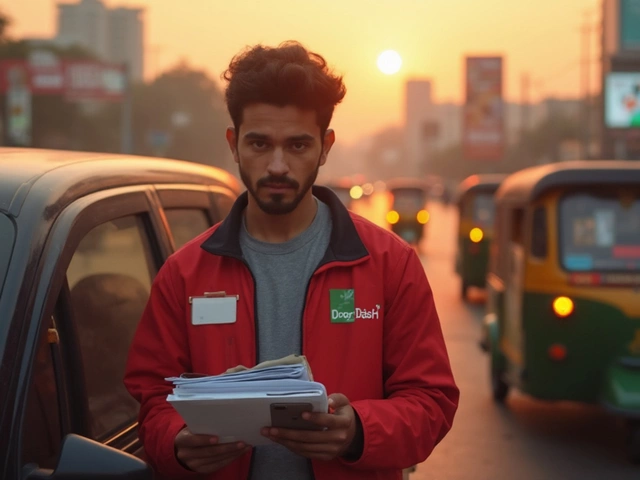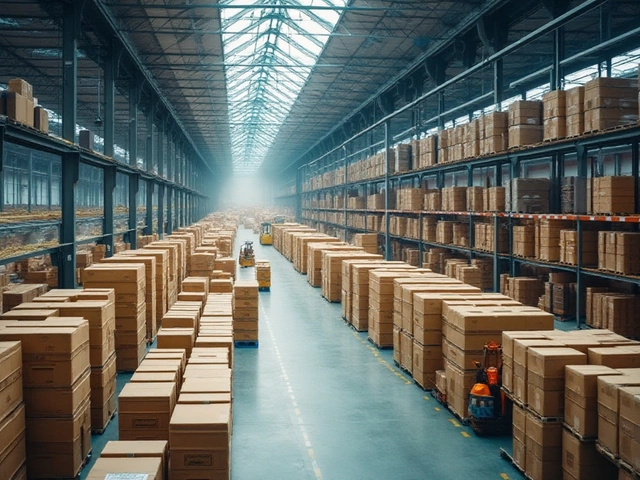In today's fast-paced world, we can't always afford to wait for standard mail delivery. Whether it's a birthday gift or urgent documents, sometimes it just has to get there fast. Lucky for us, next-day delivery services have stepped up to the plate, ensuring what you send arrives quicker than ordering a pizza.
But what are your options when it comes to speeding up mail delivery? Well, it depends on a few factors like whether you're using a courier or standard postal service. Companies like DHL, FedEx, and UPS have become household names for their speed and reliability, but don’t discount the post office just yet. Some offer next-day services that might surprise you with their affordability.
Want your package not to just arrive fast, but also safe? Be ready to shell out a bit more for added security features like tracking and insurance. It's all about weighing the costs and priorities—and if speed is at the top of your list, you're definitely in the right place.
- Understanding Next-Day Delivery Options
- Courier vs. Postal Services
- Shipping Tips for Speedy Delivery
- Hidden Costs and Considerations
- Tracking and Ensuring Safe Delivery
- Future of Fast Mail Delivery
Understanding Next-Day Delivery Options
When it comes to sending stuff fast, next day delivery has got you covered. But wait, there’s more than one way to get it done. From courier giants to trusty national postal services, here's what you need to know about your options.
Courier Services
If you're after speed, courier services like DHL, FedEx, and UPS are top players. These companies offer robust next day delivery services globally. They usually have dedicated networks, which means less chance for delays. Plus, they often specialize in tracking capabilities, letting you monitor every step your package takes.
Postal Services
If you're on a budget, your local postal service might surprise you with its own speedy solutions. In the UK, Royal Mail offers services like 'Special Delivery Guaranteed', promising delivery by the next day. It's a solid, affordable choice when time's of the essence.
Important Considerations
- Weight and Size: Different carriers have varying limits on the size and weight of your shipments. Be sure to check these in advance.
- Cut-off Times: Most couriers and postal services have specific cut-off times for ensuring next day delivery. Make sure your package is dropped off well before then to avoid any disappointment.
- Delivery Area: Some remote areas might not be covered in their standard next-day schedules. A quick postcode check is always a good idea.
By understanding these options and factors, you can make a more informed decision based on your priorities, be it cost, speed, or reliability. The key lies in not just choosing a service but making sure it aligns perfectly with your delivery needs.
Courier vs. Postal Services
When it comes to fast shipping, both couriers and postal services offer unique benefits, and the right choice often depends on your specific needs. Let's break it down.
Courier Services: Speed and Reliability
Companies like FedEx, DHL, and UPS have made a name for themselves by delivering packages worldwide with impressive speed and efficiency. These courier services are a popular choice for businesses needing swift deliveries and individuals who prioritize speed over cost. With features like door-to-door pickup, advanced tracking, and customer support, couriers offer convenience unmatched by traditional postal services.
Need a parcel delivered internationally by tomorrow? With a courier, you can rest easy knowing it's in good hands, even if it costs a bit more. They're often the go-to for vital documents like passports or business contracts where another day might just be too late.
Postal Services: Affordable and Wide Reach
On the other hand, postal services have been around for centuries and continue to provide affordable options for domestic and international shipping. While speed may not always match that of couriers, services like Priority Mail can offer surprisingly quick delivery times, often at a fraction of the cost.
Many national postal services now have partnerships with private couriers to enhance their speed and reach, such as Royal Mail's collaboration with Parcelforce in the UK, ensuring that next-day delivery is competitive almost wherever you need to send your package.
The Decision: Weighing Your Needs
Choosing between a courier and a postal service often boils down to what matters most: speed, cost, or coverage. If time is of the essence, and you're willing to pay a premium, couriers are your best bet. However, if you're looking for a balance between affordability and speed, don't rule out your trusty postal service. Consider where and when you need your parcel delivered, check service availability, and maybe even read a few reviews to gauge reliability.
Remember, each option has its pros and cons, and the right choice depends on your priorities and budget. Whether you're sending a package across the country or across the globe, it's all about meeting your delivery needs efficiently.
Shipping Tips for Speedy Delivery
Getting your mail delivered quickly can often feel like navigating a maze. But fear not—I've got you covered with some practical tips to speed things up.
Choose the Right Service
The first step to ensuring fast mail delivery is picking the right service. If next-day delivery is a must, opt for well-known couriers like DHL, FedEx, or UPS. They specialize in fast deliveries, often promising specific arrival times. If you're sticking with the postal service, make sure to select their expedited options.
Pack Smart
Proper packing can make a huge difference in how quickly your package moves through the system. Use a sturdy box, and don't forget to secure everything inside. Avoid clutter and excessive packaging, as some services might add fees or delay shipping for oversized items.
Label Clearly
A clear, accurate label is crucial. Ensure the address is correct, and include the recipient’s phone number if possible. This helps couriers contact them directly if any issues arise.
Timing is Everything
Most services have cut-off times for next-day delivery, so make sure to drop off or organize pick-up before that time. If you miss it, your package might be stuck until the next working day, delaying your fast shipping plans.
Track Your Package
Always keep an eye on your package with the tracking feature provided by the courier service. It gives you peace of mind and alerts you to any potential hiccups along the way.
Insure Valuables
If the items you're sending are pricey or irreplaceable, investing in insurance is a no-brainer. It doesn't directly speed up delivery, but it ensures you're covered if something goes awry.
All these steps can boost your chances of that package arriving as swiftly as possible. Next time you need speedy delivery, keep these tips in mind for a smoother ride.

Hidden Costs and Considerations
When opting for the speediest mail delivery options, it's easy to get caught up in the rush. But before you hit the confirm button on that next-day delivery, let's talk about some costs that might sneak up on you. It's not just about the price on the sticker—there's a bit more to it.
First off, services labeled as 'fast shipping' often have surcharges that aren't glaringly obvious at first glance. You might be looking at fees for things like fuel surcharges, weekend delivery fees, or even residential delivery surcharges if you're not sending to a commercial address.
Understanding Additional Fees
Did you know some services will cite a "remote area" fee if your destination falls out of their common delivery zones? It's worth checking if your area falls under that category. Plus, there's often an extra charge for items that are unusually large or heavy.
"Always read the fine print. What looks like a great deal might end up costing more with all the added fees," advises John Moore, a logistics expert from the Bristol Courier Conference 2024.
Insurance and Declared Value Costs
For those eager to secure a little peace of mind, insurance is vital. However, you might find yourself paying a premium, especially when it comes to high-value items. Declaring a higher value could potentially mean a steeper insurance fee, but it’s a trade-off for, well, security. Keep that in the back of your mind as you pack that priceless family heirloom or expensive tech gadget.
Impact of Delivery Timing
And here's a tip on timing—opting for a delivery on weekends or holidays could swell costs. While it's super convenient to get that package on a specific day, a little patience or planning could help you avoid special fees. Look into your carrier's timelines and check their base rates against their weekend fee schedule.
Navigating these hidden costs can sometimes feel like tiptoeing through a minefield, but awareness is key. By knowing what to expect, you're better equipped to make sure those added expenses don't surprise you when the bill arrives. Remember, planning ahead and being informed are your best defenses against unwelcome spending!
Tracking and Ensuring Safe Delivery
When using next day delivery, it's crucial to stay informed about your package's whereabouts. Almost all major courier services and postal systems offer tracking features. This means you can keep an eye on your mail at every stage of the journey, reducing anxiety and giving you peace of mind.
How Tracking Works
Couriers assign a unique tracking number to each shipment. This number allows you to check the status of your delivery online or through an app, from the moment it leaves the sender's hands until it arrives at the destination. It's like having a GPS for your package.
Postal services, despite their reputation for being less high-tech, have improved significantly in this area. Many now offer online tracking with real-time updates, much like their courier counterparts.
Ensuring Safe Delivery
Another layer of security comes from adding services like 'signature on delivery' or insurance for valuable items. This might cost more, but it's worth it if you're sending important documents or expensive items.
Here's a quick checklist to ensure safe mail delivery:
- Always double-check the recipient's address.
- Use sturdy, well-sealed packaging.
- Consider adding insurance for high-value items.
- Opt for a signature confirmation for sensitive packages.
- Keep a copy of all tracking information.
By taking these steps, not only do you minimize the risks, but you also enhance the likelihood of a smooth, on-time delivery.
Future of Fast Mail Delivery
The race to deliver mail faster than ever is heating up, and the future looks exciting. We're not just talking about slight improvements or new delivery routes. We're looking at technological breakthroughs that might change the game entirely for next-day delivery and beyond.
Drone Delivery
First off, drones are no longer just for tech fanatics. They’re seriously being considered as a viable option for mail delivery. Companies like Amazon and UPS have been testing drone services to cut through traffic woes and deliver packages straight to your door, and even top tech conferences are buzzing about this innovation.Hyperloop and High-Speed Rail
Then we've got concepts like the Hyperloop and super-fast trains inching closer to reality. Such systems could reduce cross-country shipping times massively, creating opportunities for fast shipping on a whole new scale. Imagine sending a package across the UK in mere hours.Autonomous Vehicles
Autonomous delivery vehicles are not a thing of the future anymore. Companies are already showcasing self-driving trucks that not only reduce labor costs but also speed up delivery times. These vehicles promise under-the-radar deliveries around the clock, which can drastically improve service during peak seasons.Smart Mailboxes
The humble mailbox is getting a tech upgrade too. Smart mailboxes equipped with sensors can alert you as soon as your mail arrives, while also securely holding your packages. This can enhance courier service efficiency by minimizing failed delivery attempts.| Technology | Expected Rollout |
|---|---|
| Drones | 2025-2030 |
| Hyperloop | 2030+ |
| Autonomous Vehicles | 2024-2026 |
| Smart Mailboxes | 2025-2028 |
These advancements are closer than you might think, each having the potential to revolutionize how we perceive mail delivery. While we're not there yet, staying informed on these innovations might give you a head start when they finally become mainstream.





